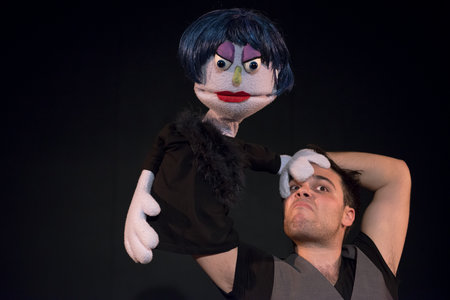
At my second show of the Toronto Fringe Festival I had an interesting conversation with a volunteer. Both of us were puppet show fans and both of us were struck by the sheer amount of puppetry available at this year’s festival. Not counting children’s shows, there are at least seven separate adult puppet shows—assuming adult puppet shows are rated PG and up–that indicate a resurgence in puppet popularity.
Toronto, Ontario, and even Canada has a wide selection of puppet companies. Toronto, for instance, has two well-known puppeteering groups: the Famous People Players and Clay and Paper Theatre. Furthermore, most people fondly remember childhood television shows that made extensive use of puppets including Under the Umbrella Tree, Fraggle Rock, and the much beloved Sesame Street.
Theatrically, puppet shows have risen to new prominence with the success of Avenue Q (2002), an adult puppet show that satirized kids puppet shows like Sesame Street, and the drama War Horse (2007). Both shows were not only big hits but also suggested there was a new adult audience for specific types of Western puppetry—something that has been commented on before.
Thus it is hardly surprising that Fringe show Baker’s Dozen highlights a Fraggle Rock connection through puppet director Mike Peterson while lead Adam Francis Proulx was part of the Canadian cast of Avenue Q. The importance of these connections is not so much the staying power of either Avenue Q or Fraggle Rock but instead draws attention to the connection between puppet shows in various mediums with strong staying power.
The ‘adult’ in the Fringe productions is supposed to reflect mature content but subject matter appears to be secondary to the actual puppeteering.
I think this ties into the festival context, specifically how Fringe works for individual performers and companies with few resources. Mochinosha’s Oni, for example, bills itself as “revealing all secrets” about Japanese shadow puppets. In this performance the story is second to the technical components of creating the puppets and how they are performed.
Most puppetry involves revealing technical machinations to a point. An audience is aware a marionette has strings so a show that has technical and cost restraints may find an audience endeared by the act of puppeteering—the design, the style, the negotiation of actor and puppet–as much as by the story itself.
In the programme for Small Wooden Shoe’s Summer Spectacular, Jacob Zimmer articulates a dislike for “the separation of ‘puppet theatre’ or ‘community spectacle’ and ‘contemporary theatre’” believing the division is “false and harmful.” Moreover, he calls attention to the problematic idea that big-budget puppet shows and—what he calls—“historic ‘puppet companies’” are the sole purveyors of puppet theatre for audiences. Rather than diminishing the success of the other companies, Zimmer wants puppetry to be part of the larger theatre culture. Zimmer’s note suggests that puppet theatre is an avenue that allows for new explorations of familiar theatrical themes by those who wish to experiment.
While puppets are a creative way to tell a story, none of these reasons addresses why this year there are so many puppet shows at the Fringe. In all likelihood there is no definitive reason why one particular style is popular at one particular time. In truth the amount of adult puppet shows may be linked to something a lot less complicated than marketing, challenging conventions, or technical limitations. Simply put, the nostalgia for puppets and the excitement of seeing puppets live compounded with festival density (there are a lot of shows in a very short period of time) may be what makes the number of puppet shows surprising rather than an actual increase in actual performances.
Photo of Adam Francis Proulx and “Muffy” by Dahlia Katz
